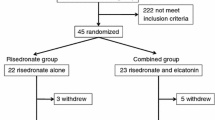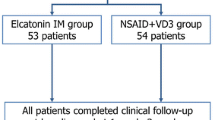Abstract
The medical use of glucocorticoids (GCs) is related to low bone mineral density (BMD). In this study we tested the hypothesis that the cumulative dose of GC is not related to BMD outcome. The study was cross-sectional in design and included healthy individuals with chronic low back pain resistant to conventional treatments. In two steroid-naive subjects cortisol and methylprednisolone (MP) concentrations were serially assessed after a single MP depot injection (160 mg epidurally). Furthermore, in 14 men and 14 postmenopausal women, previously treated with multiple epidural MP depots, endocrine parameters were analysed in relation to BMD outcomes. The minimal cumulative MP dose received by all 28 subjects was 3 g. In the two steroid-naive subjects, cortisol concentrations were completely suppressed for at least 6 days and partly recovered over the course of 30 days. During this period, MP concentrations remained detectable in plasma. In the 28 subjects, the cumulative MP dose received was 7.76±4.23 g in the men and 8.50±3.13 g in the women (mean±1SD). None of the men had osteoporosis, but osteopenia was prevalent in 78.5% according to WHO criteria extrapolated to men. Half of the women had osteoporosis and half of them had osteopenia. The body mass index (BMI) and endogenous oestradiol levels of the men were not related to BMD outcomes. Univariate linear relationships in women were found between BMI and spinal (r 0.62; P=0.02) and total hip BMD (r 0.61; P=0.03), but not femoral neck BMD. In women, relationships were also found between the total and, for protein binding-corrected oestradiol levels, and spinal BMD (r 0.70; P=0.01 and r 0.72; P=0.01, respectively) and total hip BMD (r 0.53; P=0.08 and r 0.56; P=0.05, respectively). No significance was observed between endogenous oestradiol levels and the BMD of the femoral neck. The administration of a single MP depot injection (160 mg) resembled a systemic low peak dose GC exposure. The administration of multiple MP depots in men and women with chronic low back pain revealed no relationship between cumulative GC dose and BMD. These findings support the hypothesis of a non-existent relationship between cumulative GC dose and BMD outcomes in healthy men and women with a prior GC administration of at least 3 g.
Similar content being viewed by others
Author information
Authors and Affiliations
Additional information
Received: 18 February 2002 / Accepted: 14 June 2002
Acknowledgements We are indebted to Dr Oscar L.H. van Hemel for advice during the performance of the study and to Ineke Bosman for excellent laboratory support.
Rights and permissions
About this article
Cite this article
Dubois, E., Wagemans, M., Verdouw, B. et al. Lack of relationships between cumulative methylprednisolone dose and bone mineral density in healthy men and postmenopausal women with chronic low back pain. Clin Rheumatol 22, 12–17 (2003). https://doi.org/10.1007/s10067-002-0648-3
Issue Date:
DOI: https://doi.org/10.1007/s10067-002-0648-3




